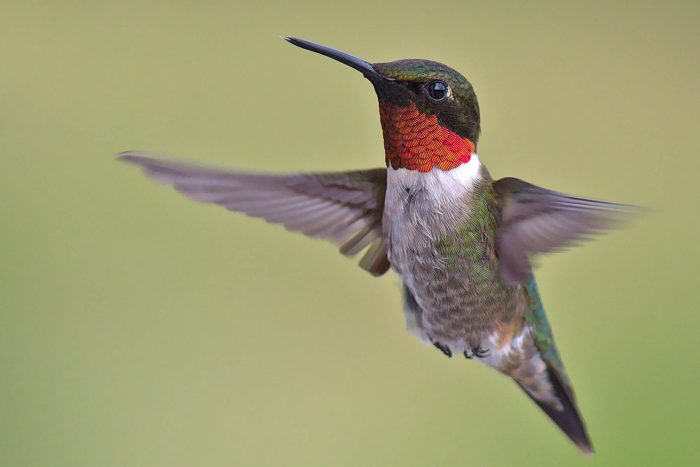Ruby-Throated Hummingbird
Archilochus colubris
The ruby-throated hummingbird is a tiny, iridescent green bird that visits forests, swamps and gardens throughout the Chesapeake Bay region from spring through autumn.
This section shows one large critter image at a time. Use the thumbnails that follow to select a specific image to display here.

This gallery contains a grid of small thumbnails. Selecting a thumbnail will change the main image in the preceding section.
Appearance
Ruby-throated hummingbirds grow to about three inches in length. They have an iridescent green head and back, a white belly and a needle-like bill. Males have a metallic, ruby red throat and a forked tail; females have a grayish throat and their tail is squared with a white tip.
Feeding
To feed, the hummingbird uses its needle-like bill to sip nectar from red, tubular flowers such as crossvine and cardinal flower. It may also feed on insects and spiders. It hovers in the air while feeding.
Predators
Hawks, blue jays and domestic cats are a few hummingbird predators.
Flight
Hummingbirds are unique because they can fly backwards and upside down. Their wings beat about 53 times per second. A slow motion video shows how quickly the bird's wings beat relative to the rest of their body.
Voice
The hummingbird gets its name from the humming sound made by its rapid wing beats. It also makes mouse-like, twittering squeaks. Males will emit a single warning note if another male enters their breeding territory.
Reproduction and life cycle
Males establish a mating territory, performing a courtship display for any female that enters. During his courtship display, a male’s wings can beat more than twice as fast as normal. After mating, the male and female separate. The female builds a tiny, two-inch nest in a tree above an open area. She lays an average of two eggs, which she incubates for 10 to 14 days. The chicks leave the nest 18 to 22 days after hatching. Hummingbirds can live up to nine years in the wild.
Did you know?
- The ruby-throated hummingbird is the only hummingbird found in the mid-Atlantic region. It is also the smallest bird in the Chesapeake Bay region.
- The bird's short legs prevent it from walking or hopping.
- Adult hummingbirds may eat twice their body weight in food each day, which they need to sustain their rapid movement and wing beats.
Sources and additional information
- Chesapeake Bay: Nature of the Estuary, A Field Guide by Christopher P. White
- Animal Diversity Web: Archilochus colubris – University of Michigan Museum of Zoology
- All About Birds: Ruby-throated Hummingbird – The Cornell Lab of Ornithology
